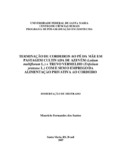| dc.creator | Santos, Maurício Fernandes dos | |
| dc.date.accessioned | 2007-11-22 | |
| dc.date.available | 2007-11-22 | |
| dc.date.issued | 2007-07-27 | |
| dc.identifier.citation | SANTOS, Maurício Fernandes dos. Termination of lambs to the foot of the mother in cultivated pasture of winter with and without the job of the creep feeding to the lamb. 2007. 61 f. Dissertação (Mestrado em Zootecnia) - Universidade Federal de Santa Maria, Santa Maria, 2007. | por |
| dc.identifier.uri | http://repositorio.ufsm.br/handle/1/10689 | |
| dc.description.abstract | The experiment objectified the termination of lambs to the foot of the mother in pasture cultivated of ryegrass and red clover with and without creep-feeding to the lamb. Evaluations in the performance, characteristics of carcass, production of commercial cuts and production of the components had been carried through not-carcass in the lambs kept to the foot of the mother and submitted to the alimentary treatments: PAST = pasture cultivated of ryegrass and red clover; APT = pasture cultivated of ryegrass and red clover + creep-feeding to the lamb during all the period of use of the grass; AP42 = pasture cultivated of ryegrass and red clover + creep-feeding to the lamb from 42 days after beginning of the use of the grass. For all the evaluated parameters of the grass, did not have interaction (P>0.05) between treatment and period, did not have difference between treatments (P>0.05) for the parameters evaluated in the grass. Animals that had received creep-feeding had presented greater (P<0.05) profit of daily average weight and lesser (P<0.05) number of days to reach the weight established of slaughter in relation to that they had only remained in pasture. The components carcass had not differed (P>0.05) in the alimentary treatments. The weight of slaughter of 28 kg was only reached in 43, 71 and 86% of the animals of treatments PAST, AP42 and APT, respectively. The job of creep-feeding better does not provide to quality and nor carcass yield, for the lambs slaughtered with 28kg. In handling pastures of similar form, the creep-feeding promotes additive effect on the efficiency of termination of the animals. | eng |
| dc.format | application/pdf | por |
| dc.language | por | por |
| dc.publisher | Universidade Federal de Santa Maria | por |
| dc.rights | Acesso Aberto | por |
| dc.subject | Carcaça ovina | por |
| dc.subject | Carne ovina | por |
| dc.subject | Lolium multiflorum Lam. | por |
| dc.subject | Trifolium pratense L | por |
| dc.subject | Sheep carcass | eng |
| dc.subject | Sheep meat | eng |
| dc.title | Terminação de cordeiros ao pé da mãe em pastagem cultivada de azevém (Lolium multiflorum L.) + trevo vermelho (Trifolium pratense L.) com e sem o emprego da alimentação privativa ao cordeiro | por |
| dc.title.alternative | Termination of lambs to the foot of the mother in cultivated pasture of winter with and without the job of the creep feeding to the lamb | eng |
| dc.type | Dissertação | por |
| dc.description.resumo | O experimento objetivou a terminação de cordeiros ao pé da mãe em pastagem cultivada de azevém e trevo vermelho com e sem a alimentação privativa ao cordeiro. Foram realizadas avaliações no desempenho, características de carcaça, produção de cortes comerciais e produção dos componentes não-carcaça nos cordeiros mantidos ao pé da mãe e submetidos aos tratamentos alimentares: PAST = pastagem consorciada de azevém e trevo vermelho.; APT = pastagem consorciada de azevém e trevo vermelho + alimentação privativa ao cordeiro durante todo o ciclo de uso do pasto; AP42 = pastagem consorciada de azevém e trevo vermelho + alimentação privativa ao cordeiro a partir de 42 dias após inicio da utilização do pasto. Para todos os parâmetros avaliados do pasto, não houve interação (P>0,05) entre tratamento e período, não houve diferença entre tratamentos (P>0,05) para os parâmetros avaliados no pasto. Animais que receberam alimentação privativa apresentaram maior (P<0,05) ganho de peso médio diário e menor (P<0,05) número de dias para atingir o peso estabelecido de abate em relação a aqueles que somente permaneceram em pastagem. Os componentes não carcaça não diferiram (P>0,05) nos tratamentos alimentares. O peso de abate de 28 kg foi atingido somente em 43, 71 e 86 % dos animais dos tratamentos PAST, AP42 e APT, respectivamente. O emprego da alimentação privativa não proporciona melhor qualidade e nem rendimento na carcaça, para cordeiros abatidos aos 28kg. Em pastagens manejadas de forma similar, a alimentação privativa promove efeito aditivo sobre a eficiência de terminação dos animais. | por |
| dc.contributor.advisor1 | Pires, Cleber Cassol | |
| dc.contributor.advisor1Lattes | http://lattes.cnpq.br/5811435302893655 | por |
| dc.contributor.advisor-co1 | Rocha, Marta Gomes da | |
| dc.contributor.advisor-co1Lattes | http://lattes.cnpq.br/1685524901627774 | por |
| dc.contributor.referee1 | Brondani, Ivan Luiz | |
| dc.contributor.referee1Lattes | http://lattes.cnpq.br/5813089147720195 | por |
| dc.contributor.referee2 | Carvalho, Paulo Afonso | |
| dc.contributor.referee2Lattes | http://lattes.cnpq.br/8191120307798107 | por |
| dc.publisher.country | BR | por |
| dc.publisher.department | Zootecnia | por |
| dc.publisher.initials | UFSM | por |
| dc.publisher.program | Programa de Pós-Graduação em Zootecnia | por |
| dc.subject.cnpq | CNPQ::CIENCIAS AGRARIAS::ZOOTECNIA | por |


